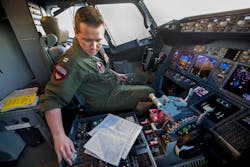Boeing to build 11 new P-8A maritime patrol aircraft with integrated sensors, avionics, and communications
PATUXENT RIVER NAS, Md. – The U.S Navy is asking the Boeing Co. to build 11 more P-8A Poseidon maritime patrol and surveillance aircraft under terms of a $1.6 billion order announced Wednesday.
Officials of the Naval Air Systems Command at Patuxent River Naval Air Station, Md., are asking the Boeing Defense, Space & Security segment in Seattle to build nine aircraft for the Navy, and two for Australia.
The P-8 is a militarized version of the Boeing 737-800 single-aisle passenger jetliner hardened for long-range ocean missions like surveillance, maritime patrol, and anti-submarine warfare. The P-8A is replacing the Lockheed Martin P-3 Orion maritime patrol turboprop aircraft.
The P-8A’s avionics flight management system and the stores management system have been developed by GE Aviation Systems in Grand Rapids, Mich. The cabin has as many as seven operator consoles.
Ultimately, the Navy plans to buy 108 P-8A aircraft from Boeing, which is building the Poseidon at its factory in Renton, Wash. The 737 fuselage and tail sections are from by Spirit AeroSystems in Wichita, Kan., and move to Renton where technicians will assemble the finished aircraft.
The Poseidon’s MX-20HD digital electro-optical and infrared (EO/IR) multi-spectral sensor turrets come from L3Harris Wescam in Burlington, Ontario. The MX-20HD is gyro-stabilized and can have as many as seven sensors, including infrared, CCDTV, image intensifier, laser rangefinder, and laser illuminator.
The Raytheon Technologies Corp. Intelligence & Space segment in McKinney, Texas, is providing the AN/APY-10 advanced airborne radar systems for the P-8A. The AN/APY-10 maritime, littoral, and overland surveillance radar is a relatively new design for the P-8A, which is replacing the previous-generation AN/APS-137 radar.
story continues below
The AN/APY-10 has reduced size, weight and power (SWaP); additional target track capability, a new color weather avoidance mode, and room for technology growth, compared to the Raytheon APS-137D(V)5 maritime surveillance radar and signals intelligence (SIGINT) system that the AN/APY-10 is replacing.
The AN/APY-10 is integrated into the Boeing mission control and display system aboard the Poseidon for control, display and data distribution. The radar also will provide ultra-high-resolution imaging modes for maritime and overland operations. The radar fits in the nose of the Poseidon.
The previous-generation APS-137D(V)5 radar provides synthetic aperture radar (SAR) for imaging stationary ships and small vessels, coastal and overland surveillance, and high-resolution imaging synthetic aperture radar (ISAR) for imaging surfaced submarines and fast surface vessels operating in coastal waters.
The P-8A will have the CAE Inc. advanced integrated magnetic anomaly detection (MAD) system, and eventually may use air-deployable unmanned aerial vehicles (UAVs) to handle magnetic anomaly detection.
Related: Navy orders identification friend-or-foe (IFF) avionics from Telephonics for P-8A Poseidon
Experts from the BAE Systems Electronic Systems segment in Nashua, N.H., are demonstrating a new radio frequency countermeasures (RFCM) electronic warfare (EW) system aboard the P-8A to enable the aircraft to protect itself from radar-guided missiles.
Boeing also is determining the feasibility of integrating the new Mobile User Objective System (MUOS) satellite communications (SATCOM) system aboard the P-8A. MUOS is a UHF communications system that operates at frequencies from 300 MHz to 3 GHz and will replace the legacy UHF Follow-On (UFO) system before that system reaches its end of life.
MUOS is intended to provide mobile users with new capabilities and enhanced mobility, access, capacity, and quality of service. Boeing is conducting a technical study to determine if it makes sense to install MUOS capability on dual SATCOM channels on the P-8A, while maintaining legacy voice, Link-11, and DAMA/DAMA-IW SATCOM with the current UHF 5 and UHF 6 radio suite aboard the aircraft.
Boeing also is determining if the Multifunctional Information Distribution System (MIDS) Tactical Air Navigation System (TACAN) would be compatible with a MUOS installation aboard the P-8A.
Meggitt Defense Systems Inc. in Irvine, Calif., is providing large electronics-cooling system called the Liquid Air Palletized System (LAPS) for thermal management of electronic components and sensors aboard the P-8A.
Meggitt’s liquid palletized solution provides essential cooling to mission-critical equipment and sensors to ensure safe flight. The system can provide as much as 64 kilowatts of cooling for the aircraft when operating above 10,000 feet, and 20 kilowatts of ground cooling. LAPS cools the computer processors, electronic and electro-optical sensors, and other heat-generating avionics aboard the P-8A.
Telephonics Corp. in Farmingdale, N.Y., is providing the aircraft's AN/UPX-43(V)1 identification friend-or-foe (IFF) avionics systems. It is a Mark XIIA monopulse and AIMS-certified IFF interrogator for command and control. The avionics subsystem enables air traffic controllers and air defenders to identify military and civilian aircraft, verify forces as friendly, and determine their bearing and range.
The Navy also plans to arm the P-8A with the MK 54 torpedo, which will be fitted with kits to enable the aircraft to release them from altitudes as high as 30,000 feet. The modified torpedoes will glide through the air and enter the water safely to enable the Poseidon to attack enemy submarines from long ranges.
The Poseidon will have the Wideband Global satellite communications (SATCOM) system, otherwise known as WGS -- a high-capacity SATCOM link that will augment and eventually replace Defense Satellite Communications System (DSCS) and Global Broadcast Service (GBS) satellites.
On this order Boeing will do the work in Seattle; Huntington Beach, Calif.; and at other U.S. locations, and should be finished by September 2024. For more information contact Boeing Defense, Space & Security online at www.boeing.com, or Naval Air Systems Command at www.navair.navy.mil.
About the Author
John Keller
Editor-in-Chief
John Keller is the Editor-in-Chief, Military & Aerospace Electronics Magazine--provides extensive coverage and analysis of enabling electronics and optoelectronic technologies in military, space and commercial aviation applications. John has been a member of the Military & Aerospace Electronics staff since 1989 and chief editor since 1995.
